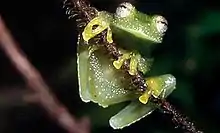Vitreorana uranoscopa
Vitreorana uranoscopa is a species of frog in the family Centrolenidae. It is found in southeastern and southern Brazil, from Minas Gerais and Espírito Santo southward to northern Rio Grande do Sul, and in northeastern Argentina; it is also likely to be found in adjacent Paraguay.[2] Common name Humboldt's grass frog has been proposed for it.[1][2]
| Vitreorana uranoscopa | |
|---|---|
 | |
| Scientific classification | |
| Kingdom: | Animalia |
| Phylum: | Chordata |
| Class: | Amphibia |
| Order: | Anura |
| Family: | Centrolenidae |
| Genus: | Vitreorana |
| Species: | V. uranoscopa |
| Binomial name | |
| Vitreorana uranoscopa (Müller, 1924) | |
| Synonyms[2] | |
| |
It occurs in primary and secondary forest at elevations below 1,200 m (3,900 ft) above sea level. It is typically found in the immediate vicinity of running water, usually clinging close to leaves of herbaceous vegetation and trees. The eggs are deposited on leaves above water, to which the tadpoles drop upon hatching. It can be a locally common species. It is not threatened as a species, but probable threats to it relate to habitat loss caused by clear-cutting, dams, tourism, and human settlement. It is present in several protected areas.[1]
References
- Garcia, P.; Segalla, M.V.; Baldo, D. & Faivovich, J. (2010). "Vitreorana uranoscopa". IUCN Red List of Threatened Species. 2010: e.T55035A11243724. Retrieved 1 February 2020.
- Frost, Darrel R. (2020). "Vitreorana uranoscopa (Müller, 1924)". Amphibian Species of the World: an Online Reference. Version 6.0. American Museum of Natural History. Retrieved 1 February 2020.
| Wikimedia Commons has media related to Vitreorana uranoscopa. |
